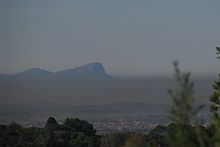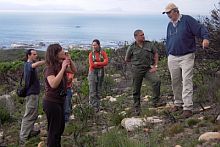SAEON to investigate Cape Town’s brown haze threat to fynbos
|
A project partnership has been forged between researchers at Arizona State University, the University of Cape Town and SAEON to investigate the potential impacts of nitrogen in air pollution on fynbos vegetation.
In May, the leader of this Mellon Foundation funded project, Prof Sharon Hall1 visited South Africa in a scoping exercise to select suitable study sites with the South African partners.
The search for study sites proved to be a challenge as they should be in areas exposed to the city’s atmospheric pollution as well as in areas protected from pollution. The sites moreover have to be the same post-fire age and on the same substrates.
What is "brown haze"?
Brown haze is made up of gases from exhaust fumes and industrial activity and include NOx, O3, SO2, aerosols and volatile organic carbons. The brown colour is caused by NO2, some of which turns to O3 as the day progresses.
In Cape Town, a brown haze develops regularly when there is no wind. It is particularly prevalent in winter when temperature inversions ensure that the gases stay trapped near the earth’s surface. Winter is also the time when the South Easterly wind, the "Cape Doctor" is least active.
Two earlier studies have documented the composition and physical and chemical dynamics of Cape Town’s brown haze. An MSc study looked at nitrogen levels in mosses in herbarium specimens and in currently growing mosses and estimated an increase in nitrogen deposition rates of 6-13 kg N ha-1 a-1 since 1950 (Wilson et al. 2009).
So why are we concerned about nitrogen deposition in fynbos?
Fynbos grows on some of the most nutrient poor soils in the world. Low nutrient soils are responsible for many plant traits that are typical of fynbos plants, such as sclerophyllous2 leaves and special nutrient uptake systems such as cluster roots found in plant groups with several hundred species such as the Proteaceae, Restionaceae families and the genus Aspalathus.
Other typical Cape genera are unable to grow once they’ve germinated until they have established specialised nutrient uptake mutualisms3 with mycorrhizal4 fungi. In fact, low nutrients may be one of the explanations for the extremely high species diversity in fynbos.
Unlike other types of plants, most typical fynbos plants are unable to respond to increased nutrients availability with increased growth. Instead, nutrients accumulate to toxic concentrations in plant tissues and the plants die. The thresholds for such toxicity is much lower than for plant species from higher nutrient environments.
The fear is that atmospheric nitrogen deposition will fertilise fynbos. This could lead to direct harm to plants that take up nutrients, or to disruptions in nutrient cycling.
What are the impacts of a city the size of Cape Town on the ecology of fynbos?
The project will address how the urban environment affects nutrient cycling and ecosystem services within intact and remnant fynbos ecosystems in the Cape Town metropolitan area. Cape Town is in a special position as a city in being immediately adjacent to one of the six floral kingdoms of the world, and this one is marked by being the smallest and having a very rich plant diversity.
The project will be one of the first to study the interactions between built environments and nature in this part of the world.
1 Prof Sharon Hall is Assistant Professor in Ecology, Evolution and Environmental Science in the School of Life Sciences at Arizona State University. Some of Prof Hall’s experience in nutrient cycling has been developed while working on the Central Arizona–Phoenix Long-Term Ecological Research (CAP LTER), one of only two LTER site in the USA to focus specifically on urban ecology.
2 Characterised by thick, hard foliage
3 Mutualism is a biological interaction between two organisms, where each individual derives a fitness benefit, for example increased survivorship (Wikipedia)
4 A mycorrhiza (Greek for fungus roots coined by Frank, 1885; typically seen in the plural forms mycorrhizae or mycorrhizas) is a symbiotic (occasionally weakly pathogenic) association between a fungus and the roots of a plant. In a mycorrhizal association, the fungus may colonize the roots of a host plant, either intracellularly or extracellularly. They are an important part of soil life. (Wikipedia)
Further reading:
Wilson, D., Stock, W.D. and Hedderson, T. 2009. Historical nitrogen content of bryophyte tissue as an indicator of increased nitrogen deposition in the Cape Metropolitan Area, South. Environmental Pollution 157 938–945












